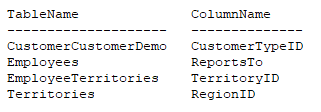By: Eli Leiba | Comments (3) | Related: > Indexing
Problem
The requirement is to create a query that will identify all SQL Server foreign keys that do not have a corresponding index built on that column for that table. Having these columns indexed can help improve SQL Server performance.
Solution
The solution involves creating a query against system views and show the table name and the column name for the columns that appear in a foreign key constraint where there is not an index setup starting with the first column of the foreign key.
Here is what the query does:
- The query consists of two main queries with an EXCEPT operator between the two queries.
- The first query is a join between sys.foreign_key_columns, sys.all_columns and sys.objects system views.
- The query lists all the foreign key columns and table names for non-Microsoft shipped objects.
- The query does not list the reference column names since it is assumed that they are indexed by the primary keys of the reference tables.
- The second query is a join between sys.index_columns, sys.all_columns and sys.objects system views.
- The query lists all the index columns that appear as the first column in the index along with the table names.
- This is done for all indexes in the database, for all the non-Microsoft shipped objects.
- The EXCEPT operator gives us all the foreign key columns and table names that do NOT appear in any index in the first column of the index.
T-SQL Code
SELECT Object_Name(a.parent_object_id) AS Table_Name ,b.NAME AS Column_Name FROM sys.foreign_key_columns a ,sys.all_columns b ,sys.objects c WHERE a.parent_column_id = b.column_id AND a.parent_object_id = b.object_id AND b.object_id = c.object_id AND c.is_ms_shipped = 0 EXCEPT SELECT Object_name(a.Object_id) ,b.NAME FROM sys.index_columns a ,sys.all_columns b ,sys.objects c WHERE a.object_id = b.object_id AND a.key_ordinal = 1 AND a.column_id = b.column_id AND a.object_id = c.object_id AND c.is_ms_shipped = 0 GO
Example Use
If I run the above query against the Northwind database this is the result.

This is helpful, but to take this a step further I want to see more information about the foreign keys and the referenced table.
T-SQL Code with Additional Data
So I took the first query and made it a CTE and then added more system views to return additional information as shown below.
WITH v_NonIndexedFKColumns AS (
SELECT
Object_Name(a.parent_object_id) AS Table_Name
,b.NAME AS Column_Name
FROM
sys.foreign_key_columns a
,sys.all_columns b
,sys.objects c
WHERE
a.parent_column_id = b.column_id
AND a.parent_object_id = b.object_id
AND b.object_id = c.object_id
AND c.is_ms_shipped = 0
EXCEPT
SELECT
Object_name(a.Object_id)
,b.NAME
FROM
sys.index_columns a
,sys.all_columns b
,sys.objects c
WHERE
a.object_id = b.object_id
AND a.key_ordinal = 1
AND a.column_id = b.column_id
AND a.object_id = c.object_id
AND c.is_ms_shipped = 0
)
SELECT
v.Table_Name AS NonIndexedCol_Table_Name
,v.Column_Name AS NonIndexedCol_Column_Name
,fk.NAME AS Constraint_Name
,SCHEMA_NAME(fk.schema_id) AS Ref_Schema_Name
,object_name(fkc.referenced_object_id) AS Ref_Table_Name
,c2.NAME AS Ref_Column_Name
FROM
v_NonIndexedFKColumns v
,sys.all_columns c
,sys.all_columns c2
,sys.foreign_key_columns fkc
,sys.foreign_keys fk
WHERE
v.Table_Name = Object_Name(fkc.parent_object_id)
AND v.Column_Name = c.NAME
AND fkc.parent_column_id = c.column_id
AND fkc.parent_object_id = c.object_id
AND fkc.referenced_column_id = c2.column_id
AND fkc.referenced_object_id = c2.object_id
AND fk.object_id = fkc.constraint_object_id
ORDER BY 1,2
The above returns the following:

You can then use this output to create new indexes for these tables and columns.
So for example, looking at the first row returned, I could create a new index on table CustomerCustomerDemo for column CustomerTypeID.
Next Steps
- Use these queries to help identify potential new indexes.
- You can use these queries to create views in your application database.
- The code was tested using: Microsoft SQL Server 2012, 2014 and 2016.
About the author
 Eli Leiba is a senior application DBA, a teacher and a senior database consultant with 19 years of RDBMS experience.
Eli Leiba is a senior application DBA, a teacher and a senior database consultant with 19 years of RDBMS experience.This author pledges the content of this article is based on professional experience and not AI generated.
View all my tips






